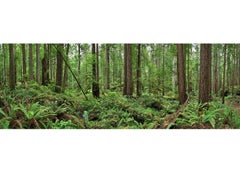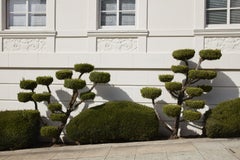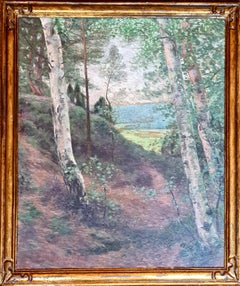Emile Roux Fabre Art
to
2
1
Overall Width
to
Overall Height
to
3
3
3
3
2
1
1
1
1
2
1
1
3
10,083
2,772
1,380
1,375
3
Artist: Emile Roux Fabre
Provence
By Emile Roux-Fabre
Located in Houston, TX
Classic etching of Provence by French artist E. Roux-Fabre, circa 1930.
Original artwork on paper displayed on a white mat with a gold border. Mat fits a standard-sized frame. Archi...
Category
1930s Emile Roux Fabre Art
Materials
Etching
French Etching Bridge
By Emile Roux-Fabre
Located in Houston, TX
French etching of arched bridge by artist E. Roux-Fabre, circa 1930.
Original artwork on paper displayed on a white mat with a gold border. Mat fits a ...
Category
1930s Emile Roux Fabre Art
Materials
Etching
Vintage Landscape Etching - The Flock
By Emile Roux-Fabre
Located in Houston, TX
Vintage black and white etching of a farmer leading his flock of sheep to a pasture bordered by a small village by French artist Emile Roux Fabre, circa 1930. Signed in pencil lower ...
Category
1930s Emile Roux Fabre Art
Materials
Ink, Paper
Related Items
Redwoods - large format nature observation panorama of green redwoods forest
By Erik Pawassar
Located in San Francisco, CA
a large scale photograph of lush emerald green nature biotope, a highly detailed observation of the natural beauty of the Northern California redwood forest
Redwoods by Erik Pawassa...
Category
21st Century and Contemporary Contemporary Emile Roux Fabre Art
Materials
Archival Ink, Archival Paper, Photographic Paper, Giclée, Archival Pigment
Topiary II - large format photograph of ornamental shaped sidewalk trees
By Frank Schott
Located in San Francisco, CA
large scale photogaph from a series of photographic observances capturing the antics of urban gardening and whimsical botanical art of topiaries' green minimalism
TOPIARY II by Fran...
Category
21st Century and Contemporary Contemporary Emile Roux Fabre Art
Materials
Archival Ink, Photographic Paper, Archival Pigment, Archival Paper, Giclée
Abstract India Edition 3/5 Linocut Print Green Blue Turquoise Architectural
By Mukesh Sharma
Located in Norfolk, GB
There is a natural and raw understanding in Mukesh Sharma’s prints that both depict, and are influenced by, the Rajastani communities of his home town in rural India. In these Limited Edition fine-art prints, made over a period of twenty years, we are offered the colours of India’s ancient land, the textures, light and the patterns that are everywhere. In the patterns of the arable fields to the jali's (carved screens) in the architecture. This work is however not romantic nor nostalgic but shows a deeper rooted need to offer a visual heritage of place, of where the artist is from and the journey that he is taking. The results are both compelling and honest.
Mukesh Sharma, Celebration B, Lino-cut on Drawing paper
Edition: 3 of 5, 2005
Image size: 47 x 39 cm / Sheet size: 79 x 55 cm
Unframed
Mukesh Sharma's work:
It is often in childhood that paths are set for what we will become. Mukesh Sharma hails from a rural, agricultural village in Rajasthan, India. His Father is a craftsman who fixed and mended farm machinery and understood the working parts in the processes. Sharma followed in his Father’s footsteps, as is often the case in Indian families, but his was not the machines of the fields but the presses of the printing studio.
Like his Father, Mukesh Sharma is fascinated with understanding how things work and how he can manipulate the metal in his hands. It is not surprising then that his medium of choice is printing. One of the most physically challenging of all the practices, it can often be physically challenging as well as technical and detailed.
In his youth, Sharma would draw with stones on walls and floors. He was lucky his family encouraged this and he is grateful for his early art-training at the Jaipur School of Art but it was at the Baroda Art Department that he was introduced to the great printing traditions of Jyoti Bhatt...
Category
Early 2000s Abstract Emile Roux Fabre Art
Materials
Archival Ink, Archival Paper, Linocut, Archival Pigment
$1,708
H 31.11 in W 21.66 in
Authentic Japanese Woodblock Print-White Cat-Hanabusa Itchō-Edo-Re-carved 1920s
Located in London, GB
This rare Original 1920s authentic print is a Taisho Period Woodblock print published from the Japan 1920's The Nippon Mokuhan Gasui, Masterpieces Series.;
it is authentically hand ...
Category
1920s Edo Emile Roux Fabre Art
Materials
Ink, Handmade Paper
$392 Sale Price
30% Off
H 11.82 in W 7.72 in D 0.04 in
Stone Statue, Madura, India, 1914
Located in Amsterdam, NL
Stone statue in the temple at Madura, India, 1914
Signed with initials top right
Pencil on paper, 21.2 x 16.7 cm
Literature:
Ernst Braches en J.F. Heijbroek, W.O.J. Nieuwenkamp,B...
Category
1910s Art Nouveau Emile Roux Fabre Art
Materials
Paper, Pencil
Part of the ring-wall of the Taj Mahal, Agra, India, 1914
Located in Amsterdam, NL
Part of the ring-wall of the Taj Mahal, Agra, India, 1914
Signed with initials and dated bottom right
Black chalk on paper, 45.5 x 53 cm
Literature:
Ernst Braches en J.F. Heijbro...
Category
1910s Art Nouveau Emile Roux Fabre Art
Materials
Paper, Chalk
$22,953
H 17.92 in W 20.87 in D 1.19 in
Mounts Bay Mood. Contemporary limited edition etching
By Ian Laurie
Located in Brecon, Powys
Mounts Bay Mood. Limited Edition etching from the well collected studio of Ian Laurie. Signed and numbered 14 of 50. Each one of the 25 is slightly different in tone and color
Image...
Category
21st Century and Contemporary Impressionist Emile Roux Fabre Art
Materials
Etching
Meadow-Limited Edition Etching, Signed by Artist
By Russa Graeme
Located in Chesterfield, MI
Limited Edition Etching (125/200). Signed by Artist. Measures 32.75 x 25.5 inches and is unframed. The piece is in Fair/Distressed Condition-discoloration/yellowing primarily in the ...
Category
Late 20th Century Emile Roux Fabre Art
Materials
Etching
Marfa ( Prada ) - large format photograph of iconic conceptual art installation
By Frank Schott
Located in San Francisco, CA
Large scale photograph of PRADA MARFA, a permanently installed pop architectural land art project sculpture by artists Elmgreen and Dragset, inaug...
Category
21st Century and Contemporary Contemporary Emile Roux Fabre Art
Materials
Archival Ink, Archival Paper, Photographic Paper, Giclée
Venice Beach Seascape, Long Wave, Nautical Scene in Blue Tones, Limited Edition
By Kind of Cyan
Located in Barcelona, ES
This is an exclusive handprinted limited edition cyanotype.
This beautiful cyanotype is titled "Long Wave in Venice Beach" and it shows an outstanding wave in one of the most iconic ...
Category
2010s Realist Emile Roux Fabre Art
Materials
Paper, Emulsion, Watercolor, Engraving, Etching, Monotype
Authentic Japanese Woodblock Print-Birds and Flowers-Edo-Fan Re-carved 1920s
By Utagawa Sadahide
Located in London, GB
This rare Original 1920s authentic print is a Taisho Period Woodblock print published from the Japan 1920's The Nippon Mokuhan Gasui, Masterpieces Series.;
it is authentically hand ...
Category
1920s Emile Roux Fabre Art
Materials
Ink, Handmade Paper
$451 Sale Price
40% Off
H 7.88 in W 12.6 in D 0.04 in
"House" Color Etching on Paper of a Medieval Era Home Surrounded by Trees
By Josef Eidenberger
Located in Austin, TX
Copperplate etching
Hand signed and inscribed by the artist in pencil.
Image size: 13.5 x 11.5 in.
Frame size: 24 x 22 in.
A naturalistic color etching on paper featuring a classic ...
Category
1980s Naturalistic Emile Roux Fabre Art
Materials
Ink, Archival Paper, Etching
$300
H 13.75 in W 11.5 in
Previously Available Items
The Forest, Large Barbizon School, Oil on Canvas Wooded Landscape
By Emile Roux-Fabre
Located in Cotignac, FR
A French Barbizon School oil on canvas forest view by Emile Roux-Fabre. The painting is signed and dated bottom left with a dedication.
A charming view of forest glade leading out to a valley landscape beyond. The artist has captured the magic feeling of the cool forest shade against the sunshine of the landscape beyond. The texture of the bark on the silver birch trees, the contrast of the leaves on the trees all framing the perspective to the view beyond. An extremely accomplished and atmospheric painting.
The Barbizon school of painters was part of an art movement towards Realism in art, which arose in the context of the dominant Romantic Movement of the time. The Barbizon school was active roughly from 1830 through 1870. It takes its name from the village of Barbizon, France, on the edge of the Forest of Fontainebleau, where many of the artists gathered. Most of their works were landscape paintings, but several of them also painted landscapes with farmworkers, and genre scenes of village life. Some of the most prominent features of this school are its tonal qualities, colour, loose brushwork, and softness of form.
The leaders of the Barbizon school were: Théodore Rousseau, Charles-François Daubigny, Jules Dupré, Constant Troyon, Charles Jacque, and Narcisse Virgilio Díaz. Jean-François Millet lived in Barbizon from 1849, but his interest in figures with a landscape backdrop sets him rather apart from the others. Jean-Baptiste-Camille Corot was the earliest on the scene, first painting in the forest in 1829, but his work has a poetic and literary quality which sets him somewhat apart. Other artists associated with the school, often pupils of the main group, include: Henri Harpignies, Albert Charpin, François-Louis Français and Émile van Marcke.
In 1824 the Salon de Paris exhibited works of John Constable, an English painter. His rural scenes influenced some of the younger artists of the time, moving them to abandon formalism and to draw inspiration directly from nature. Natural scenes became the subjects of their paintings rather than mere backdrops to dramatic events. During the Revolutions of 1848 artists gathered at Barbizon to follow Constable's ideas, making nature the subject of their paintings. The French landscape became a major theme of the Barbizon painters.
Millet extended the idea from landscape to figures — peasant figures, scenes of peasant life, and work in the fields. In The Gleaners (1857), for example, Millet portrays three peasant women working at the harvest. Gleaners are poor people who are permitted to gather the remains after the owners of the field complete the main harvest. The owners (portrayed as wealthy) and their laborers are seen in the back of the painting. Millet shifted the focus and the subject matter from the rich and prominent to those at the bottom of the social ladders. To emphasize their anonymity and marginalized position, he hid their faces. The women's bowed bodies represent their everyday hard work.
In the spring of 1829, Jean-Baptiste-Camille Corot came to Barbizon to paint in the Forest of Fontainebleau, he had first painted in the forest at Chailly in 1822. He returned to Barbizon in the autumn of 1830 and in the summer of 1831, where he made drawings and oil studies, from which he made a painting intended for the Salon of 1830; "View of the Forest of Fontainebleau'" (now in the National Gallery in Washington) and, for the salon of 1831, another "View of the Forest of Fontainebleau"'. While there he met the members of the Barbizon school: Théodore Rousseau, Paul Huet, Constant Troyon, Jean-François Millet, and the young Charles-François Daubigny.
During the late 1860s, the Barbizon painters attracted the attention of a younger generation of French artists studying in Paris. Several of those artists visited Fontainebleau Forest to paint the landscape, including Claude Monet, Pierre-Auguste Renoir, Alfred Sisley and Frédéric Bazille. In the 1870s those artists, among others, developed the art movement called Impressionism and practiced 'plein air' painting. In contrast, the main members of the school made drawings and sketches on the spot, but painted back in their studios.
The Post-Impressionist painter Vincent Van Gogh studied and copied several of the Barbizon painters as well, including 21 copies of paintings by Millet. He copied Millet more than any other artist. He also did three paintings in Daubigny's Garden.
The Barbizon painters also had a profound impact on landscape painting in the United States. This included the development of the American Barbizon school by William Morris Hunt. Several artists who were also in, or contemporary to, the Hudson River School studied Barbizon paintings for their loose brushwork and emotional impact. A notable example is George Inness, who sought to emulate the works of Rousseau. Paintings from the Barbizon school also influenced landscape painting in California. The artist Percy Gray...
Category
Early 20th Century Emile Roux Fabre Art
Materials
Canvas, Oil
H 24.02 in W 20.08 in D 0.79 in
Forest of Fontainebleau
By Emile Roux-Fabre
Located in Houston, TX
Elegant etching of forest path by French artist, E. Roux-Fabre, 1937. Signed lower right.
Original artwork on paper displayed on a white mat with a gold border. Mat fits a standar...
Category
1930s Emile Roux Fabre Art
Materials
Etching
Emile Roux Fabre art for sale on 1stDibs.
Find a wide variety of authentic Emile Roux Fabre art available for sale on 1stDibs. You can also browse by medium to find art by Emile Roux Fabre in etching, canvas, fabric and more. Not every interior allows for large Emile Roux Fabre art, so small editions measuring 16 inches across are available. Customers who are interested in this artist might also find the work of Theophile Narcisse Chauvel, Jean François Millet, and Charles François Daubigny. Emile Roux Fabre art prices can differ depending upon medium, time period and other attributes. On 1stDibs, the price for these items starts at $225 and tops out at $906, while the average work can sell for $250.


